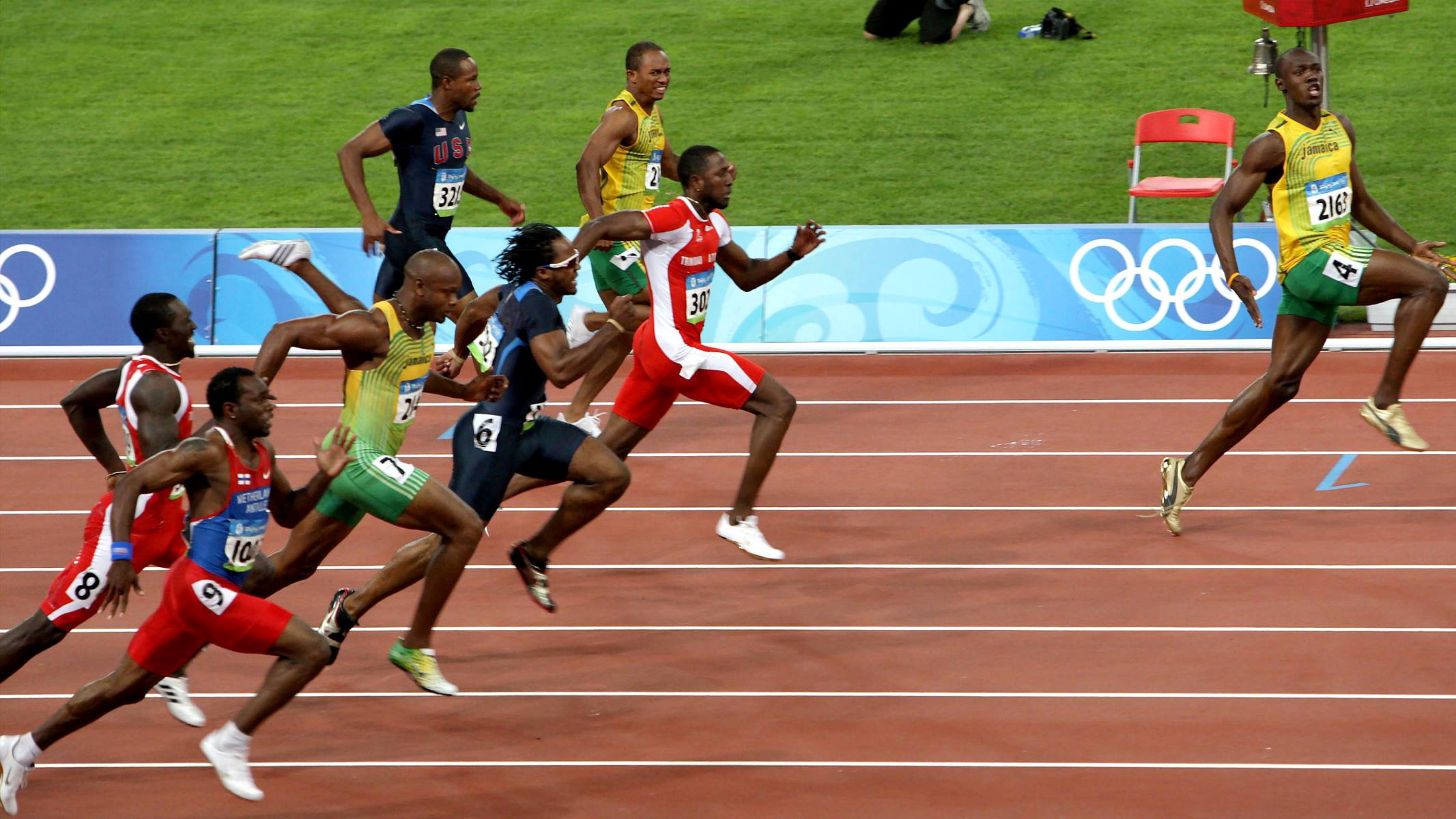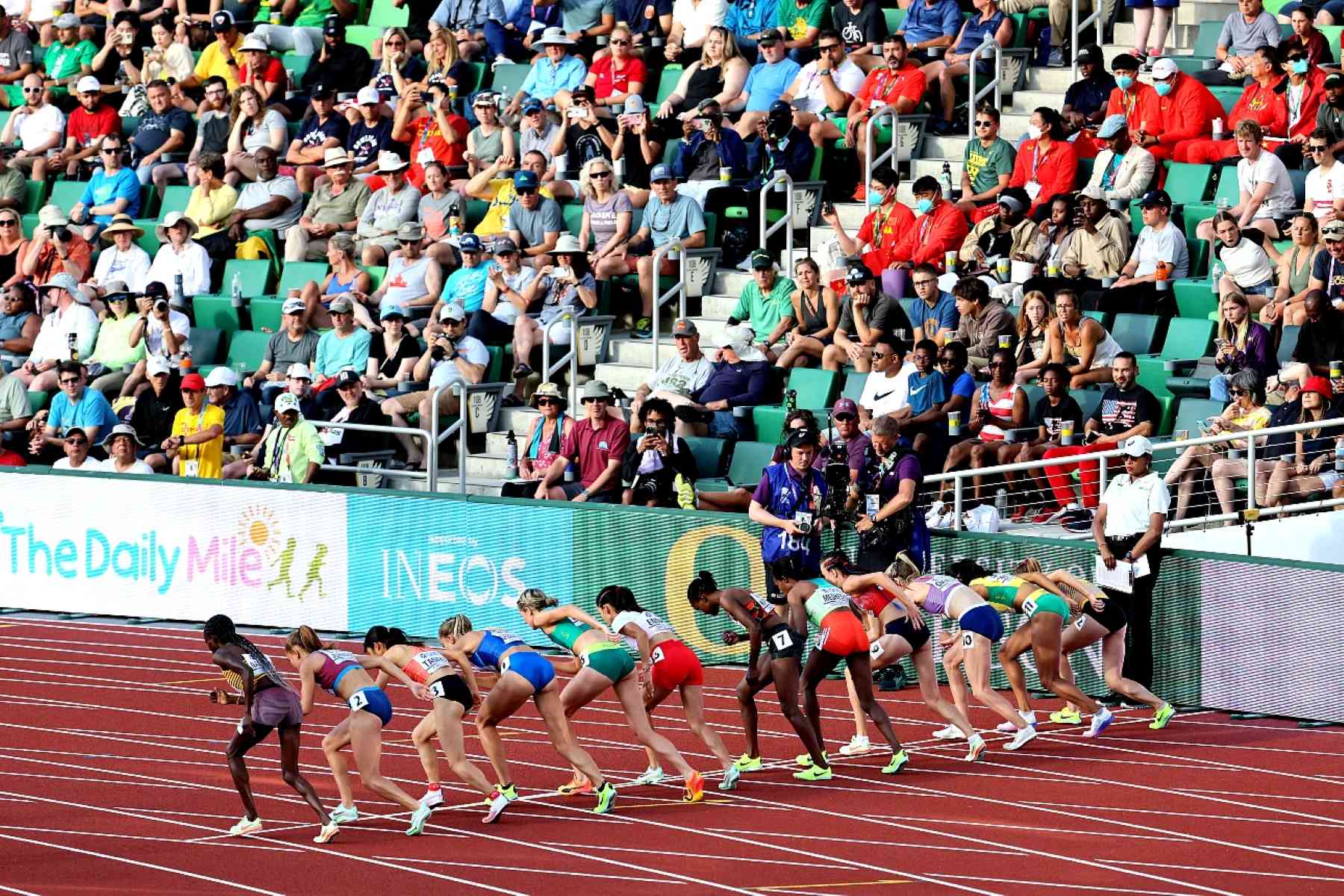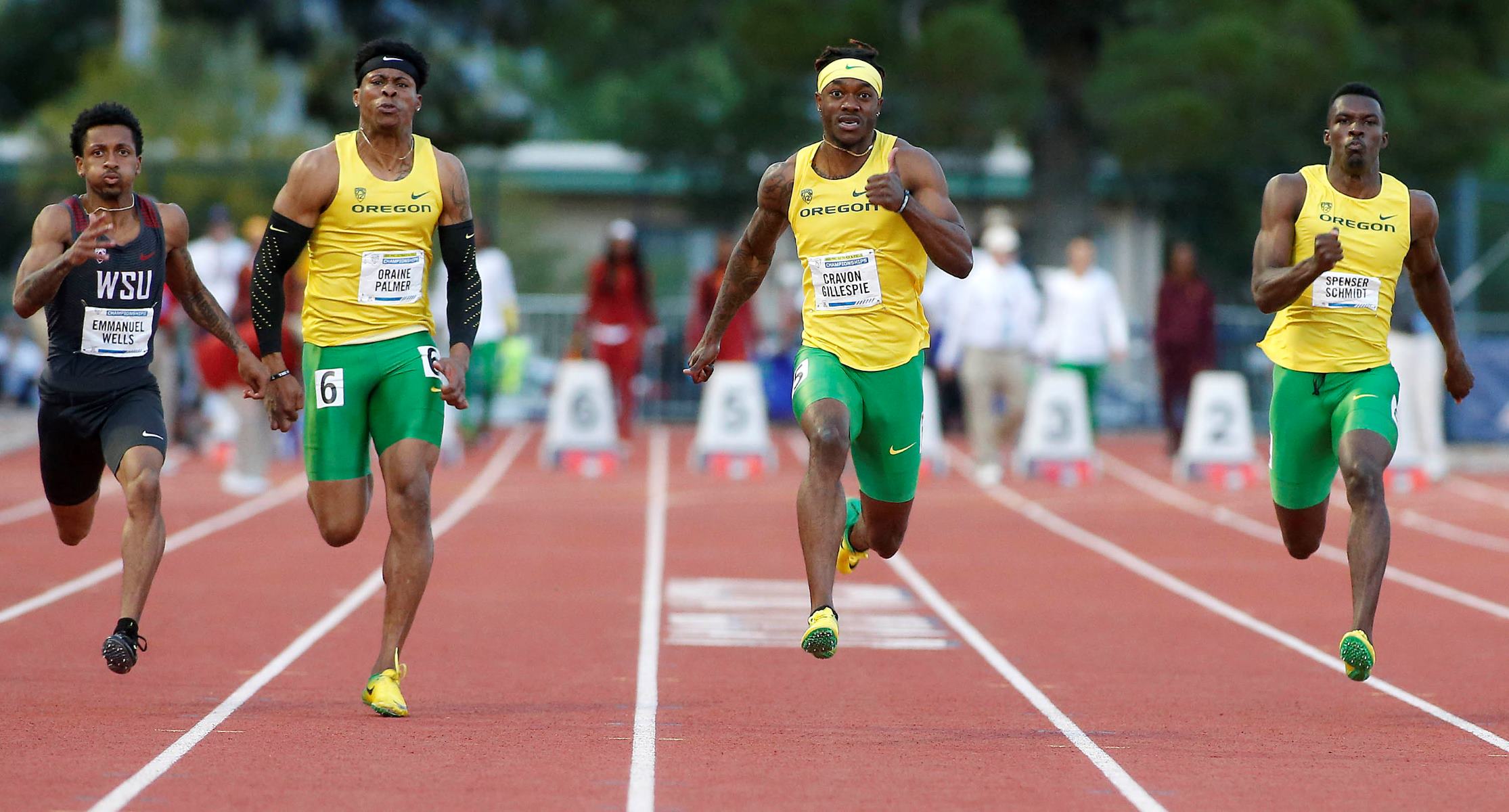

Featured
How To Do Track And Field
Modified: January 2, 2024
Learn how to do track and field with our featured guide, providing expert tips and techniques to improve your skills and performance.
Introduction
Track and field is a thrilling sport that combines speed, power, endurance, and technique. It encompasses a wide range of events, including sprints, hurdles, long jump, high jump, shot put, javelin throw, and many more. Whether you are an aspiring athlete or someone looking to try something new, track and field offers a variety of options to suit different interests and abilities.
Participating in track and field not only provides an opportunity for physical fitness and competition but also fosters personal growth and character development. It requires discipline, dedication, and perseverance, pushing athletes to strive for their personal best and constantly improve their performance.
Choosing to participate in track and field can be a rewarding and fulfilling experience, regardless of age or skill level. From sprinting down the straightaway with sheer power to mastering the intricate technique of the pole vault, each event offers its own unique challenges and rewards.
In this comprehensive guide, we will explore the world of track and field and provide you with practical tips and advice to help you excel in your chosen events. We’ll cover everything from selecting the right events for you to building endurance and stamina, developing speed and power, mastering techniques, and implementing effective training strategies.
We will also delve into the importance of proper warm-up and cool-down techniques, injury prevention and recovery, nutrition and hydration, and mental preparation for competitions. Whether you’re a beginner or an experienced athlete, this guide will equip you with the knowledge and tools to take your track and field performance to the next level.
So, strap on your running shoes or step into the throwing circle, and let’s dive into the exciting world of track and field!
Choosing the Right Track and Field Events
When it comes to track and field, one of the first steps in your journey is deciding which events to compete in. With a wide array of options available, it’s essential to choose events that not only align with your interests but also suit your physical attributes and abilities. Here are some factors to consider when selecting your track and field events:
- Personal Interest: Start by exploring the different events and identifying the ones that pique your curiosity. Do you prefer the explosiveness of the sprints or the grace of the high jump? Figuring out what excites you will make the training process more enjoyable and help you stay motivated.
- Physical Attributes: Consider your natural strengths and abilities. Are you naturally fast? Do you have excellent hand-eye coordination? Knowing your strengths can guide you towards events that allow you to play to your advantage.
- Body Type: Different events favor different body types. Sprinters, for example, tend to have muscular builds for explosive power, while long-distance runners often have leaner physiques for improved endurance. Take into account your body type and how it aligns with the demands of various events.
- Previous Experience: If you have previous experience in a particular track and field event, it may be wise to stick with what you are familiar with. Building on existing skills can give you a head start in improving your performance.
- Experimentation: Don’t be afraid to try out different events to see what resonates with you. Track and field offers a wide range of possibilities, and you may discover hidden talents in events you never considered before.
It’s important to remember that your track and field journey should be an enjoyable and rewarding experience. While competition is part of the sport, placing too much emphasis on winning may lead to burnout or decreased motivation. Embrace the process of self-improvement and focus on personal achievements and growth.
By carefully considering your personal interests, physical attributes, body type, previous experience, and willingness to experiment, you can make an informed decision about which track and field events are the right fit for you. This will set a solid foundation for your training and ultimately contribute to your success in the sport.
Building Endurance and Stamina
Endurance and stamina are essential components of success in track and field. Whether you’re a sprinter, a distance runner, or participating in field events that require repetitive explosive efforts, having a strong cardiovascular and muscular endurance base is crucial. Here are some tips to help you build endurance and stamina for your track and field events:
- Consistent Cardiovascular Training: Incorporate regular cardiovascular exercises, such as running, cycling, or swimming, into your training routine. Aim for at least three to four sessions per week, gradually increasing the duration and intensity over time.
- Interval Training: Interval training involves alternating between high-intensity bursts of activity and active recovery periods. Incorporate intervals into your workouts to improve both your aerobic and anaerobic capacity. For example, perform sprints followed by a period of jogging or walking.
- Long Slow Distance Runs: Long slow distance (LSD) runs are a cornerstone of building endurance for distance runners. These runs should be done at a comfortable pace for an extended duration, gradually increasing the distance over time.
- Strength Training: Include resistance training exercises in your workout routine to build muscular endurance. Focus on compound exercises like squats, lunges, deadlifts, and bench presses, aiming for higher repetitions and lower weights.
- Cross-Training: Incorporate cross-training activities, such as swimming, cycling, or using an elliptical machine, to minimize the risk of overuse injuries and enhance overall fitness.
- Proper Recovery: Adequate rest and recovery are crucial for building endurance. Ensure you prioritize sleep, incorporate rest days into your training schedule, and practice techniques like foam rolling and stretching to aid in muscle recovery.
- Progressive Overload: Gradually increase the intensity, duration, or distance of your workouts over time. This progressive overload principle helps challenge your body and stimulate continuous improvement.
Remember that building endurance and stamina is a gradual process that requires patience and consistency. It’s essential to listen to your body and avoid overtraining, as pushing too hard can lead to injuries or burnout. Consulting with a coach or a qualified fitness professional can also provide valuable guidance in creating a well-rounded training program specific to your needs and goals.
By implementing these strategies, you can develop the necessary endurance and stamina to excel in your track and field events. Building a solid foundation of cardiovascular fitness and muscular endurance will not only enhance your performance but also improve your overall health and well-being.
Developing Speed and Power
Speed and power are critical factors in track and field performance, regardless of the event you’re participating in. Whether you’re a sprinter aiming to explode out of the starting blocks or a jumper looking to generate maximum force in takeoff, developing speed and power can significantly enhance your performance. Here are some strategies to help you improve your speed and power:
- Sprint Training: Incorporate specific sprint workouts into your training routine to improve your explosiveness and speed. These workouts can include intervals of sprinting at maximum effort followed by recovery periods or practicing proper sprinting technique with the help of a coach.
- Plyometric Exercises: Plyometric exercises involve explosive movements that train the muscles to generate power. Examples include box jumps, jump squats, and depth jumps. Incorporate these exercises into your strength training routine to improve your power output.
- Strength Training: Building strength is crucial for generating power in track and field events. Focus on exercises that target the major muscle groups involved in your event, such as squats, lunges, deadlifts, and bench presses. Aim for lower repetitions and higher weights to build both strength and power.
- Explosive Medicine Ball Training: Incorporate medicine ball exercises that involve explosive throws, slams, or rotational movements into your training routine. This type of training helps develop power and transfer that power to your chosen event.
- Hill Training: Incorporate hill sprints or hill repeats into your training program. Running uphill forces your muscles to work harder and enhances your power and speed by improving stride length and power output.
- Proper Technique: Work on refining your technique in your specific event. Proper form and technique can optimize your speed and power output. Enlist the help of a coach who can provide guidance and feedback on your technique.
- Dynamic Warm-Up: Prior to your training or competition, perform a dynamic warm-up that includes mobility exercises, dynamic stretches, and drills specific to your event. This prepares your muscles for the intense effort required for speed and power.
It’s important to note that developing speed and power takes time and consistent effort. Be patient with yourself and gradually increase the intensity and volume of your training. Overtraining or pushing too hard can lead to injuries and setbacks. Listen to your body, give yourself adequate rest and recovery, and consult with a coach or qualified professional for guidance.
By incorporating these strategies into your training routine, you can enhance your speed and power, leading to improved performance in your track and field events. Remember, proper technique, strength training, explosive exercises, and targeted training specific to your event will all contribute to your development as a powerful and fast athlete.
Mastering the Techniques
Mastering the techniques is crucial for success in track and field. Regardless of your event, honing your skills and perfecting the technical aspects can significantly improve your performance. Here are some tips to help you master the techniques in your chosen track and field events:
- Seek Professional Guidance: Work with a coach or experienced athlete who can provide you with proper guidance and instruction. They can assess your technique, identify areas for improvement, and provide drills and exercises to help you master the specific techniques required for your event.
- Break It Down: Break down the technique into smaller components and focus on improving each part individually. Mastering the fundamental aspects of the technique will build a solid foundation for advanced skills.
- Visualization: Use the power of visualization to mentally rehearse the correct technique. Take the time to visualize yourself executing flawless movements in your event. This technique can help improve your muscle memory and enhance your performance.
- Video Analysis: Record yourself performing your event and review the footage with your coach or a trained eye. This allows you to identify areas where improvements can be made and make necessary adjustments to your technique.
- Drills and Repetition: Incorporate specific drills into your training routine that target the key movements and techniques used in your event. Focus on quality repetitions, making sure each repetition is performed with proper technique.
- Slow Motion Practice: Practice your technique in slow motion, focusing on every detail of the movement. This helps you develop a deep understanding of the mechanics involved and allows you to make corrections in real-time.
- Mental Focus: Develop a strong mental focus and concentration during your training sessions and competitions. Being mentally present and engaged allows you to execute the techniques with precision and efficiency.
- Consistency and Patience: Mastery of techniques takes time and consistent practice. Be patient with yourself and allow for gradual improvement. Consistent practice and repetition will help solidify the correct technique.
Remember that mastering the techniques in track and field is an ongoing process. It requires a combination of physical practice, mental focus, and expert guidance. Be open to feedback, embrace the learning process, and stay committed to continuous improvement.
By implementing these strategies and dedicating yourself to mastering the techniques, you can elevate your performance and reach new heights in your track and field events.
Training Strategies for Track and Field
To excel in track and field, it’s important to implement effective training strategies that target the specific demands of your events. These strategies encompass a combination of conditioning, strength training, and event-specific drills. Here are some training strategies to help you enhance your performance in track and field:
- Periodization: Implement a periodized training plan that divides your training into distinct phases, such as off-season, pre-season, competition season, and recovery periods. This allows for targeted training adaptations and optimal performance during competitions.
- Event-Specific Workouts: Design training sessions that simulate the demands of your chosen event. Incorporate event-specific drills, techniques, and intensities to improve your performance. For example, if you’re a sprinter, focus on explosive starts and acceleration in your workouts.
- Strength Training: Include regular strength training sessions to develop overall strength, power, and muscular endurance. Emphasize compound exercises that strengthen the muscles involved in your event. Consult with a strength and conditioning coach for a tailored program.
- Speed Development: Dedicate specific training sessions to speed development. This can include sprint intervals, overspeed training, and resistance training to improve acceleration and top-end speed.
- Endurance Training: Incorporate endurance training sessions into your routine to develop the necessary stamina for your event. This can include long runs, tempo runs, or interval workouts to improve cardiovascular fitness.
- Recovery and Rest: Allow adequate time for recovery and rest to avoid overtraining and injuries. Incorporate active recovery days, rest days, and proper sleep into your training schedule to optimize your body’s ability to adapt and perform at its best.
- Dynamic Warm-Up and Mobility: Prior to each training session or competition, perform a dynamic warm-up and mobility routine to prepare your body for the specific movements and reduce the risk of injuries. This can include mobility drills, dynamic stretching, and activation exercises.
- Video Analysis and Feedback: Use video analysis to evaluate your technique and make necessary adjustments. Review footage of your training sessions or competitions with your coach or a trained professional to identify areas for improvement.
- Goal Setting: Set specific, measurable, achievable, relevant, and time-bound (SMART) goals for your track and field performance. Having clear goals and milestones will help guide your training and track your progress.
- Listen to Your Body: Pay attention to the signals your body gives you. If you’re feeling fatigued or experiencing pain, take the necessary rest and recovery time. Pushing through injuries or ignoring warning signs can lead to long-term setbacks.
Remember, training strategies should be tailored to your specific event and individual needs. It’s important to consult with a coach or training professional who can provide personalized guidance based on your goals and abilities.
By incorporating these training strategies into your track and field regimen, you can optimize your performance, make progress, and achieve your goals in the sport.
Proper Warm-Up and Cool-Down Techniques
A proper warm-up and cool-down routine is essential for preparing your body for intense activity and aiding in recovery after a track and field session. These routines help to increase flexibility, improve blood flow, prevent injuries, and optimize performance. Here are some techniques to ensure an effective warm-up and cool-down:
- Warm-Up:
- Gradual Intensity Increase: Start your warm-up with low-intensity exercises, such as jogging or dynamic stretching, to gradually increase your heart rate and warm up your muscles.
- Dynamic Stretching: Incorporate dynamic stretching exercises into your warm-up routine. These involve active movements that mimic the movements of the activity you are about to perform. Focus on dynamic stretches that target the major muscle groups used in your specific event.
- Joint Mobilization: Perform gentle, controlled movements to mobilize your joints. This helps to improve range of motion and prepare your joints for the stresses of track and field exercises.
- Event-Specific Drills: Include event-specific drills in your warm-up routine. For sprinters, this could involve short sprints or running with high knees. Jumpers may perform bounding exercises or takeoff drills. These drills help to activate the muscles used in your event and improve neuromuscular coordination.
- Reaction Drills: If your event involves reacting quickly, incorporate reaction drills into your warm-up. This can include starting on a whistle or reacting to visual cues to simulate the demands of your event.
- Stay Hydrated: Drink water before and during your warm-up to stay hydrated and ensure optimal performance.
- Cool-Down:
- Light Cardiovascular Exercise: After your track and field session, engage in light cardiovascular exercise, such as a slow jog or brisk walk, to gradually decrease your heart rate and facilitate recovery.
- Static Stretching: Include static stretching exercises during your cool-down to promote muscle relaxation and flexibility. Focus on stretching the major muscle groups used in your event, holding stretches for 15-30 seconds without bouncing.
- Foam Rolling or Self-Massage: Use a foam roller or massage tool to target tight or sore muscles. This can help release tension, alleviate muscle soreness, and improve recovery.
- Hydration and Nutrition: Replenish fluids and eat a balanced meal or snack post-workout to replenish energy stores and support muscle recovery.
- Reflect and Review: Take a moment to reflect on your training session or competition. Review what went well, what can improve, and any observations about your performance. This reflection can help inform future training adjustments.
Remember, the warm-up and cool-down routines should be tailored to your specific event and individual needs. They should not be rushed or neglected, as they play a crucial role in optimizing performance and enhancing recovery.
By incorporating proper warm-up and cool-down techniques into your track and field routine, you can minimize the risk of injuries, improve flexibility, and optimize your overall performance.
Injury Prevention and Recovery
In track and field, like any other sport, injuries can occur due to the high impact and intense nature of the activities involved. It’s essential to prioritize injury prevention and implement proper recovery strategies to keep your body in peak condition. Here are some tips to help you prevent injuries and facilitate recovery:
- Proper Conditioning: Develop a solid foundation of strength, flexibility, and cardiovascular fitness through targeted conditioning exercises. This improves your body’s ability to handle the demands of track and field events.
- Gradual Progression: Avoid sudden increases in training volume or intensity, as this can put undue stress on your body. Gradually progress your workouts and give yourself ample time to adapt to new challenges.
- Listen to Your Body: Pay attention to any signs of discomfort, pain, or fatigue. If you experience persistent pain or notice unusual symptoms, consult with a healthcare professional to address the issue promptly.
- Proper Technique: Mastering proper technique in your events can help reduce the risk of injuries. Focus on maintaining good form and seek coaching or expert guidance to ensure you’re executing the movements correctly.
- Rest and Recovery: Allow for sufficient rest and recovery between training sessions. Incorporate rest days into your schedule and ensure you’re getting an adequate amount of sleep each night. This allows your body to repair and rejuvenate, reducing the risk of overuse injuries.
- Cross-Training: Engage in cross-training activities to reduce the repetitive impact on your body. This can involve low-impact exercises like swimming or cycling to maintain fitness while giving your body a break from track and field-specific movements.
- Proper Nutrition: Fuel your body with a balanced diet rich in nutrients to support muscle recovery and injury prevention. Stay hydrated, consume adequate protein, and eat a variety of fruits, vegetables, and whole grains.
- Stretching and Flexibility: Include dynamic warm-up exercises and static stretching in your routine to improve flexibility and range of motion. This can help prevent muscle imbalances and reduce the risk of strains or sprains.
- Strength and Stability: Incorporate strength and stability exercises into your training program to build resilience in your muscles and joints. Focus on exercises that target your core, balance, and joint stability.
- Seek Professional Help: If you experience an injury, seek prompt medical attention or consult with a physical therapist. They can provide appropriate treatment and rehabilitation exercises to aid in your recovery.
Remember, injury prevention and recovery are ongoing processes. Prioritizing your physical well-being and taking proactive steps to reduce the risk of injuries will enhance your longevity and performance in track and field.
By implementing these tips and strategies, you can minimize the likelihood of injuries and recover effectively if they do occur, allowing you to stay healthy and perform at your best.
Track and Field Nutrition and Hydration
Nutrition and hydration play a crucial role in maximizing performance and supporting recovery in track and field. Proper fueling before, during, and after training sessions and competitions is essential for optimal performance. Here are some nutrition and hydration tips to help you excel in track and field:
- Pre-Workout Nutrition: Consume a balanced meal or snack 1-2 hours before your training session or competition. Include carbohydrates for energy, lean proteins for muscle repair, and healthy fats for sustained energy.
- Hydration: Drink water throughout the day to stay well-hydrated. Aim for at least 8-10 glasses of water daily, and drink according to thirst during exercise. Monitor your urine color — it should be pale yellow, indicating adequate hydration.
- During-Workout Hydration: Stay hydrated during your workouts by sipping water or a sports drink in small amounts at regular intervals. For intense or longer workouts, consider sports drinks that contain electrolytes and carbohydrates to replenish fluids and energy.
- Recovery Nutrition: Consuming a combination of protein and carbohydrates within 30 minutes after workouts can help kick-start recovery. Opt for a snack or shake that contains a 3:1 or 4:1 ratio of carbohydrates to protein to replenish glycogen stores and support muscle repair.
- Carbohydrate Loading: For longer-duration events like distance running, consider carbohydrate loading in the days leading up to the competition. Increase your carbohydrate intake to maximize glycogen stores and enhance endurance.
- Healthy Snacks: Choose nutrient-dense snacks throughout the day to fuel your training. Opt for options like fruits, vegetables, nuts, yogurt, or whole-grain crackers to provide a balanced mix of carbohydrates, protein, and healthy fats.
- Meal Timing: Plan your meals and snacks strategically around your training sessions to optimize energy levels. Eat a balanced meal with quality carbohydrates, lean proteins, and healthy fats 2-3 hours before workouts, and have a small snack with easily digestible carbohydrates and protein 30-60 minutes before training.
- Vitamins and Minerals: Ensure you’re getting a variety of vitamins and minerals through a balanced diet. Consider consulting with a registered dietitian to assess your nutrient needs and determine if any supplements are necessary.
- Proper Recovery: Adequate post-workout nutrition and hydration are crucial for recovery. Replenish fluids, consume protein and carbohydrates, and consider incorporating foods or supplements with anti-inflammatory properties, like tart cherry juice or omega-3 fatty acids, to support muscle repair and reduce inflammation.
- Individual Needs: Each athlete may have unique nutritional demands. Consider working with a registered dietitian who specializes in sports nutrition to create a personalized nutrition plan tailored to your specific needs, goals, and dietary preferences.
Remember, nutrition and hydration strategies should be individualized and experimented with during training to assess what works best for you. Consistency, proper fueling, and hydration will contribute to improved performance, enhanced recovery, and overall well-being in track and field.
By implementing these nutrition and hydration tips, you can optimize your training, support your body’s needs, and achieve your full potential in track and field.
Mental Preparation for Track and Field Competitions
In addition to physical training, mental preparation is essential for success in track and field competitions. Having a strong and focused mindset can help you overcome challenges, manage performance anxiety, and perform at your best. Here are some tips for effective mental preparation in track and field:
- Goal Setting: Set clear and achievable goals for each competition. Break them down into smaller, measurable targets that you can work towards. Having specific goals helps to keep you focused and motivated.
- Visualize Success: Practice visualization techniques, where you mentally rehearse your performance and envision yourself executing perfect movements and achieving your goals. This mental imagery can enhance confidence and improve performance.
- Positive Self-Talk: Cultivate a positive mindset through affirmations and positive self-talk. Replace negative thoughts and self-doubt with positive statements that promote confidence, self-belief, and resilience.
- Focus on the Process: Instead of fixating solely on the outcome, focus on the present moment and the process of performing your best. Concentrate on executing proper technique and being fully engaged in the task at hand.
- Develop Routines: Establish pre-competition routines that help you get into the right mental state. This could involve specific warm-up exercises, visualization techniques, or listening to music that boosts your confidence and focus.
- Breathing and Relaxation: Incorporate deep breathing exercises and relaxation techniques to calm your mind and body. Practicing controlled breathing can help reduce stress and anxiety, promoting a state of readiness and focus.
- Coping Strategies: Identify coping strategies for managing performance anxiety or nerves. This could involve techniques such as positive self-talk, visualization, or utilizing a specific mantra or image that instills calmness and confidence.
- Learn from Setbacks: Acknowledge that setbacks and failures are a part of the journey. Use them as valuable learning opportunities to identify areas for improvement and grow both mentally and physically.
- Stay Present: Avoid getting distracted by what your competitors or others are doing. Focus on your own performance and stay present in the moment. Trust in your training and abilities.
- Embrace Pressure: Instead of viewing pressure as a negative, reframe it as an opportunity to rise to the occasion and showcase your skills. Embrace the challenge and use the adrenaline and heightened focus to your advantage.
- Seek Support: Lean on your support system, whether it’s your coach, family, or teammates. Surround yourself with individuals who believe in you and can provide encouragement and guidance.
Remember, mental preparation is an ongoing process. It takes time and practice to develop a strong mental game. Implementing these strategies consistently will help you build resilience, boost confidence, and perform at your peak in track and field competitions.
By prioritizing your mental preparation alongside physical training, you’ll be equipped with the tools to overcome challenges and perform at your best when it matters most.
Conclusion
Track and field is a sport that combines speed, power, endurance, and technique, offering a wide range of events for athletes to choose from. Whether you’re a sprinter, a jumper, a thrower, or a distance runner, this comprehensive guide has provided valuable insights and strategies to help you excel in your chosen events.
We discussed the importance of selecting the right events based on personal interest, physical attributes, and previous experience. Building endurance and stamina, developing speed and power, and mastering the techniques specific to your event are crucial steps in enhancing your performance. Implementing effective training strategies, proper warm-up and cool-down techniques, and injury prevention measures are vital for your long-term success in track and field.
We also emphasized the significance of track and field nutrition and hydration, highlighting the role they play in fueling your body, supporting recovery, and optimizing performance. Additionally, we discussed the importance of mental preparation, including goal setting, visualization, positive self-talk, and developing routines to enhance your mental game.
As you embark on your journey in track and field, remember that progress takes time, dedication, and consistency. Celebrate small victories along the way and learn from setbacks. Continuously assess and adjust your training and mental strategies to suit your evolving needs and goals.
Whether you’re a seasoned athlete or a beginner, this guide serves as a valuable resource to help you navigate the world of track and field. Embrace the challenges, lean on your support system, and stay committed to your growth and development as an athlete.
Now, let’s lace up our shoes, step onto the track, and chase our track and field dreams with passion, discipline, and determination!









